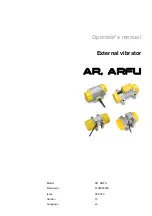
INTRODUCTION
• Do not carry out repair operations with someone sitting in the driver's seat, unless the person is a trained technician
who is assisting with the operation in question.
• Do not operate the machine or use any of the implements from different positions, other than the driver's seat.
• Do not carry out operations on the machine with the engine running, unless specifically indicated.
• Bring all hydraulic cylinders to the home positions (down, retracted, etc.) before engine shut down.
• Stop the engine and check that the hydraulic circuits are pressure-free before removing caps, covers, valves, etc.
• All repair and maintenance operations must be carried out using extreme care and attention.
• Service steps and platforms used in the workshop or elsewhere should be built according to the applicable stan-
dards and legislation.
• Disconnect the Power Take-Off (PTO) and label the controls to indicate that the machine is being serviced.
• Brakes are inoperative when manually released for repair or maintenance purposes. Use blocks or similar devices
to secure the machine in these conditions.
• Only use specified towing points for towing the machine. Connect parts carefully. Make sure that all pins and/or
locks are secured in position before applying traction. Never remain near the towing bars, cables or chains that are
operating under load.
• When loading or unloading the machine from the trailer (or other means of transport), select a flat area capable of
sustaining the trailer or truck wheels. Firmly secure the machine to the truck or trailer and lock the wheels in the
position used by the carrier.
• Electric heaters, battery-chargers and similar equipment must only be powered by auxiliary power supplies with
efficient ground insulation to avoid electrical shock hazards.
• Always use suitable hoisting or lifting devices when raising or moving heavy parts.
• Keep bystanders away.
• Never use gasoline, diesel oil or other inflammable liquids as cleaning agents. Use non-inflammable, non toxic
commercially available solvents.
• Wear safety goggles with side guards when cleaning parts with compressed air.
• Never use open flames for lighting when working on the machine or checking for leaks.
• When carrying out checks with the engine running, request the assistance of an operator in the driver's seat. The
operator must maintain visual contact with the service technician at all times.
• If operating outside the workshop, position the machine on a flat surface and lock in position. If working on a slope,
lock the machine in position. Move to a flat area as soon as is safely possible.
• Maintenance and repair operations must be carried out in a clean and dry area. Clean up any water or oil spillage
immediately.
• Do not create piles of oil or grease-soaked rags as they represent a serious fire hazard. Always store rags in a
closed metal container.
• Before engaging the machine, make sure that there are no persons within the machine or implement range of action.
• Empty your pockets of all objects that may fall accidentally unobserved into the machine inner compartments.
• When metal parts are sticking out, use protective goggles or goggles with side guards, helmets, special footwear
and gloves.
• When welding, use protective safety devices: tinted safety goggles, helmets, special overalls, gloves and footwear.
All persons present in the area where welding is taking place must wear tinted goggles. NEVER LOOK DIRECTLY
AT THE WELDING ARC WITHOUT SUITABLE EYE PROTECTION.
48142788 28/04/2017
14
Summary of Contents for 555912001
Page 9: ...48142788 28 04 2017 Find manuals at https best manuals com...
Page 10: ...INTRODUCTION 48142788 28 04 2017 1 Find manuals at https best manuals com...
Page 30: ...INTRODUCTION ZEIL06CS0135F0A 3 48142788 28 04 2017 21...
Page 61: ...INTRODUCTION 48142788 28 04 2017 52...
Page 81: ...This as a preview PDF file from best manuals com Download full PDF manual at best manuals com...
















































